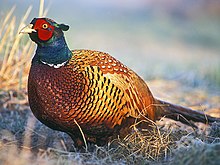Wildlife law in England and Wales
Wildlife law in England and Wales is the
Scope
A "wild bird" is: ..."Any bird of a species which is ordinarily resident in or is a visitor to the European territory of any member state in a wild state but does not include poultry or, except in sections 5 and 16, any game bird."[2] It is an offence to kill, injure, or take any wild bird, to have possession of a wild bird (alive or dead) or any part of a wild bird, to obstruct or prevent any wild bird from using its nest, to take or destroy a wild bird's egg, to have possession of a wild bird's egg or any part of an egg. It is also an offence to keep or confine a wild bird in a cage or other receptacle in which it cannot stretch its wings freely.[3]
A "game bird" is a
was also a game bird but this has been hunted to extinction in the UK.A "specially protected wild animal" is: a
The law defines certain other species as vermin and landowners are permitted (or, in the case of wild rabbits, are required) to cull them.
Enforcement
Police can, without warrant, on suspicion with reasonable cause of an offence under the Wildlife and Countryside Act 1981, stop and search; seize and detain evidence; or make an arrest.[6]
Most wildlife crimes are crimes of strict liability. There is a general defence for well-intended welfare-related actions such as taking an injured animal for tending or treatment, or for the euthanasia of a seriously injured animal that has no chance of recovery.[7]
Generally, proceedings must be brought within six months of the prosecutor coming into possession of evidence which, in his opinion, warrants proceedings. They may not be brought later than two years after the date of the offence. The maximum penalty for most wildlife crimes is six months' imprisonment and a fine of up to £5,000. The Court may also order the offender to pay or contribute towards the prosecution costs.[8]
History
Game laws
The history of wildlife management begins with the

The
Emergence of wildlife conservation
The late 19th century saw the passage of the first pieces of wildlife conservation legislation and the establishment of the first nature conservation societies. The Sea Birds Preservation Act of 1869 was passed in Britain as the first nature protection law in the world[9] after extensive lobbying from the Association for the Protection of Seabirds.[10]
The
The
During the society's early years, membership tended to be made up of specialist naturalists and its growth was comparatively slow. The first independent Trust was formed in Norfolk in 1926 as the Norfolk Naturalists Trust, followed in 1938 by the Pembrokeshire Bird Protection Society which after several subsequent changes of name is now the Wildlife Trust of South and West Wales and it was not until the 1940s and 1950s that more Naturalists' Trusts were formed in Yorkshire, Lincolnshire, Leicestershire and Cambridgeshire. These early Trusts tended to focus on purchasing land to establish nature reserves in the geographical areas they served.
Statutes
This is a list of relevant statutes. Laws which have been fully repealed are not listed here.
Covers rabbits and hares.
This act is now mostly repealed. An unrepealed section imposes an obligation on anyone setting spring snares to check them at least once a day.
The Pests Act prohibits most kinds of spring traps. It also puts almost the whole of England and Wales (except the
This Act is mostly unrelated to wildlife, but contains a helpful paragraph: "Wild creatures, tamed or untamed, shall be regarded as property, but a person cannot steal a wild creature unless... it has been reduced into possession by or on behalf of another person".[16]
This Act gives ministers strong powers to remove a threat to agriculture,[17] except in the case of badgers or European Protected Species.[18]
Prohibits the capture or killing of wildlife by means of self-locking snares, bows, crossbows, and explosides other than firearms ammunition.
A consolidating Act from the previous Deer Acts.
Makes it an offence to use badger tongs, to dig for a badger, or to disturb it within its sett, or to release a dog into a sett.
Defines a wild mammal as one which is neither domestic nor captive. Makes it an offence to mutilate, kick, beat, nail or otherwise impale, stab, burn, stone, crush, drown, drag or asphyxiate any wild mammal with intent to inflict unnecessary suffering.[19]
This was excluded from the Law Commission's consultation.
This puts a legal duty on public bodies to take biodiversity into account when exercising their functions.[20]
Sources
- Law Commission: Wildlife Law: A Consultation Paper. London: The Stationery Office Limited, 2006. ISBN 978-0118405348
- Whittaker, Geoff (ed): Focus: Wildlife crimes in Farm Law #183 (Feb 2012). London: Informa UK Ltd. ISSN 1479-537X
- Whittaker, Geoff (ed): One Law for Wildlife? in Farm Law #189 (Sept 2013). London: Informa UK Ltd. ISSN 1479-537X
Notes
- ^ Farm Law #189, p. 4.
- ^ Wildlife and Countryside Act 1981, Section 27
- ^ Wildlife and Countryside Act 1981, Section 8.
- ^ Wildlife and Countryside Act 1981, Section 27.
- ^ Law Commission 2006, p. 19.
- ^ Law Commission 2006, p. 20.
- ^ Conservation of Habitats and Species Regulations 2010, Section 42
- ^ Farm Law #183, p. 20.
- ^ G. Baeyens, M. L. Martinez (2007). Coastal Dunes: Ecology and Conservation. Springer. p. 282.
- ^ "Protecting seabirds at Bempton Cliffs".
- ^ a b "Milestones". RSPB. Retrieved 19 February 2007.
- ^ "History of the RSPB". RSPB. Retrieved 19 February 2007.
- ^ "Wicken Fen National Nature Reserve". Wicken Fen..
- ^ Wildlife Trust for Bedfordshire, Cambridgeshire, Northamptonshire and Peterborough
- ISBN 978-0-300-09632-3.
- ^ Theft Act 1968, Section 4(4)
- ^ Law Commission 2006, p. 92.
- ^ Law Commission 2006, p. 52.
- ^ Wild Mammals (Protection) Act 1996, Section 1
- ^ Law Commission 2006, p. 28.
